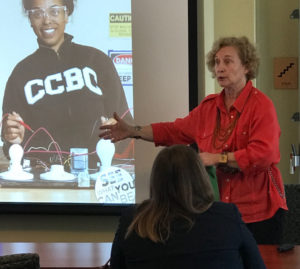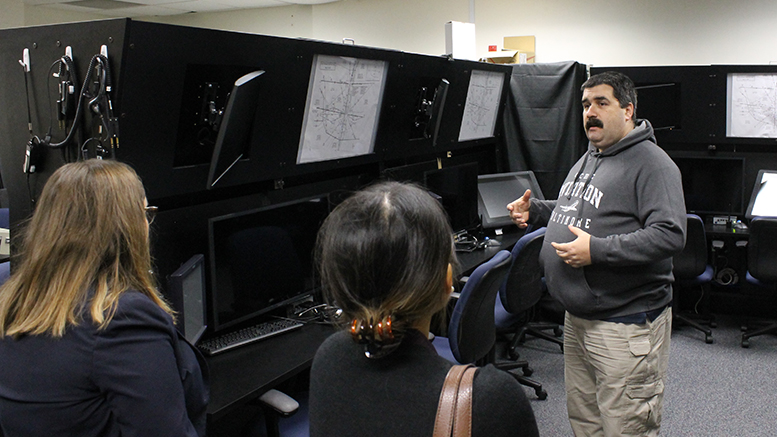CATONSVILLE, Md. — A handful of congressional staffers on Friday visited the Community College of Baltimore County (CCBC) for a first-hand look at its workforce development programs, particularly its short-term programs as Congress mulls whether to open Pell Grant eligibility to such programs.
Community colleges are comprehensive institutions, but workforce development is the “guts” of what they do, CCBC President Sandra Kurtinitis told the visitors, which included higher education and workforce advocates.
“Students come to us because they want to improve their lives, their families and their communities,” said Kurtinitis, who also serves as chair of the American Association of Community Colleges board of directors.
Knowing your students

CCBC President Sandra Kurtinitis explains to visiting congressional staffers the college’s student demographics and the types of businesses the college serves. (Photo: CCBC)
Kurtinitis outlined the demographics of her college, which are similar to that of many community colleges, to illustrate their backgrounds. The average age of a CCBC student is 38; more than half work 20 or more hours a week; about one-third receive Pell grants; 12 percent enter the college directly from high school; and about 55 percent of students enroll in noncredit courses.
That presents a challenge for these students, who have limited time as they balance family and work responsibilities while trying to upgrade their skills for a promotion or a better-paying job, Kurtinitis said. They also often face financial constraints, she added, noting that they frequently cannot pay for a program that costs $2,000 to $2,500, even though completing it would likely double their income.
That’s where expanding Pell eligibility to certain short-term programs can help. The idea has garnered support on both sides of the aisle in Congress, with backing from community colleges and business and industry, many of which are desperate for skilled workers.
Making short-term programs eligible for federal student aid would increase federal costs by about $1 billion over 10 years, most of which would be for Pell grants. That’s according to a Congressional Budget Office score of the PROSPER Act, a House bill to reauthorize the Higher Education Act that would expand student-aid eligibility.
Various training models
The congressional staffers visited CCBC, in part, because it’s participating in a federal pilot program that allows Pell to go toward certain short-term programs. Workforce development staff at CCBC answered key questions on quality assurance and outlined the various program models that the college uses. For example, CCBC runs traditional format programs, where the classroom experience mirrors a workplace, said Steven Jurch, director of health and human services. These are typically used to train people for medical front office and welding jobs.
There is also a support services model, which includes recruitment, job readiness, case management and job placement. This typically involves an employer partner, which usually recruits for entry-level positions from a local population that needs help with basic academics or skills, Jurch said. The jobs include dental assistant and certified apartment maintenance technician.
The college also has programs that provide workforce preparation on a work site, said Jay Bouis, director of technical training. They include: embedded (where training is done at an employer location), work and learn (which includes “low touch” opportunities, such as internships and clinics), and apprenticeships (that encompass registered, “unregistered” and industry-recognized apprenticeships).
Paying for it
Eligibility for the short-term Pell pilot, run through a U.S. Education Department experimental sites program, requires, in part, that the programs are at least 600 clock hours and lead to gainful employment.
At CCBC, 37 students applied for the short-term Pell pilot, and 23 were offered grants, according to college officials. A dozen accepted the grant and completed their programs, which included six students in nursing assistant, three in medical official assistant and three in commercial driver’s license programs.
Eleven students offered a Pell Grant didn’t take it. Nine of them didn’t enroll at the college, but two did enroll in credit classes, according to the college.
CCBC staff also outlined the pros and cons so far with the short-term Pell option. On the plus side: the college created information forms that it distributed on its campuses and through its website that garnered student interest. On the minus side, since the awarding was done manually, it required more staff hours. Also, because the grants in the pilot were assigned randomly to applicants, it seems to have confused some students, which is possibly why so few students applied for it or accepted the grant, college officials said.

